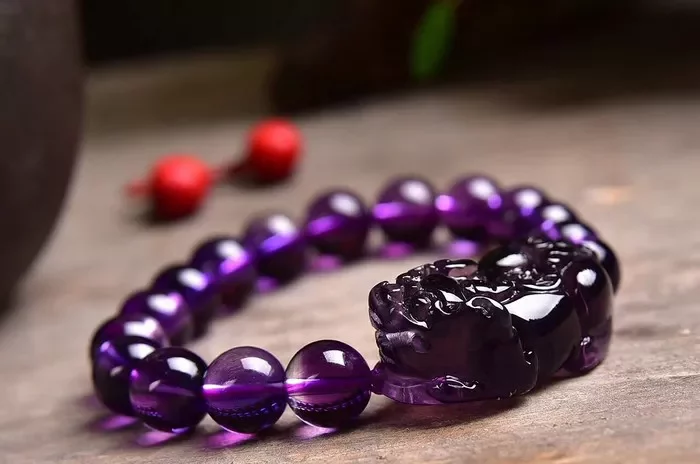Amethyst necklaces are highly valued for their unique purple hue and mystical aura. As a jewelry appraiser, distinguishing genuine amethyst from imitations is crucial. This guide will provide a detailed, step-by-step method for identifying authentic amethyst necklaces, ensuring you make informed purchases and appreciate the beauty of this gemstone.
Understanding Amethyst
What is Amethyst?
Amethyst is a variety of quartz with a distinctive violet to purple color. Its name derives from the Greek word “amethystos,” meaning “not drunk,” due to ancient beliefs that it could prevent intoxication. Amethyst is primarily found in Brazil, Uruguay, Sri Lanka, and Madagascar.
Properties of Genuine Amethyst
- Color: Genuine amethyst displays a rich, deep purple color with varying shades and tones. Natural color variations and striations are common.
- Hardness: Amethyst has a hardness of 7 on the Mohs scale, making it durable but susceptible to scratches if not properly cared for.
- Clarity: Natural amethyst can have inclusions, such as small cracks or mineral deposits, which add to its unique charm.
- Transparency: While some amethyst can be translucent, highly transparent pieces are rare and usually more valuable.
Visual Inspection
Color and Tone
Examine the Color: Genuine amethyst has a natural, deep purple color that may vary from light lavender to deep violet. Imitations often have a more uniform, artificial color.
Check for Color Variations: Natural amethyst will have color gradients and striations. If the color is too uniform or lacks these variations, it may be an imitation.
Clarity and Inclusions
Inspect for Inclusions: Natural amethyst often contains internal flaws, such as small cracks, bubbles, or mineral deposits. These are a sign of authenticity.
Look for Artificial Clarity: If the amethyst appears too clear or flawless, it may have been treated or is an imitation.
Cut and Shape
Examine the Cut: Genuine amethyst is often cut into various shapes, such as rounds, ovals, and cabochons. The cut should be clean and well-polished.
Check for Irregularities: If the cut appears粗糙 or the edges are uneven, it may indicate poor craftsmanship or an imitation.
Physical Testing
Density and Weight
Compare the Weight: Genuine amethyst has a specific gravity of around 2.65. Compare the weight of the necklace with known amethyst pieces of similar size. If it feels lighter or heavier, it may be an imitation.
Feel the Density: Hold the necklace in your hand. Genuine amethyst feels denser than glass or plastic imitations.
Hardness Test
Scratch Test: Use a hard object, such as a steel nail, to gently scratch the surface of the gemstone. Genuine amethyst will not scratch easily, but be careful not to damage the gem.
Check for Scratch Marks: Examine the scratch area under a magnifying glass. Genuine amethyst should show minimal wear, while softer materials like glass or plastic will scratch more easily.
Testing with Tools
UV Light Test
Use a UV Light: Genuine amethyst may fluoresce under ultraviolet light, appearing to glow slightly. While not all amethyst will fluoresce, the presence of fluorescence can be a positive indicator.
Observe the Reaction: Expose the necklace to a UV light source and observe any fluorescence. If it does not react, it does not necessarily mean it is fake, but it may require further testing.
Refractometer Test
Use a Refractometer: A refractometer measures the refractive index of the gemstone. Genuine amethyst has a refractive index of around 1.54 to 1.55.
Measure the Refractive Index: Place a drop of immersion oil on the refractometer prism and place the amethyst on top. Adjust the refractometer until you get a reading. Compare this with known values for amethyst.
Spectroscope Test
Use a Spectroscope: A spectroscope analyzes the absorption lines in the gemstone’s spectrum. Genuine amethyst will have specific absorption lines.
Analyze the Spectrum: Shine a light through the spectroscope and observe the absorption lines. Compare these with known absorption lines for amethyst.
Additional Considerations
Certificate of Authenticity
Request a Certificate: Genuine amethyst necklaces often come with a certificate of authenticity or appraisal. This document provides details about the gemstone’s origin, quality, and treatments.
Verify the Certificate: Ensure the certificate is from a reputable gemological laboratory. Look for signatures, stamps, and contact information for verification.
Price and Value
Compare Prices: Genuine amethyst necklaces vary in price depending on quality, size, and origin. If the price seems too good to be true, it may be an indication of an imitation.
Understand the Market: Research current market prices for amethyst necklaces. Compare prices from different sources to get a sense of what to expect.
Reputation of the Seller
Check Reviews: Look for online reviews and testimonials about the seller. Reputable sellers will have positive feedback and a history of selling genuine gemstones.
Ask Questions: Don’t hesitate to ask the seller questions about the necklace’s origin, treatments, and authenticity. A knowledgeable seller will be able to provide detailed answers.
Chemical Testing (Advanced)
Acid Test: While not commonly used for amethyst, an acid test can be performed by a professional to check for reactions that indicate treated or imitation gemstones.
Heat Test: Some imitations may change color or melt under extreme heat. However, this test is destructive and should only be performed by a professional.
Conclusion
In summary, genuine amethyst necklaces are characterized by their natural purple color, hardness, clarity, and specific gravity. By carefully inspecting the gemstone’s appearance, performing physical tests, and verifying its authenticity through certificates and seller reputation, you can confidently identify a real amethyst necklace. Happy collecting!
Related topic:
- Is the David Yurman Amethyst Pendant Worth the Investment?
- Can a Carved Amethyst Necklace Enhance Your Spiritual Well-being?
- Can You Layer Amethyst and Alexandrite Necklaces Together?


